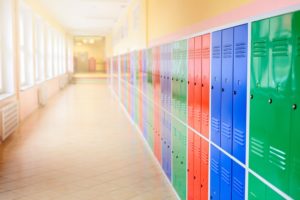As a facility manager of a school, you’re familiar that during cold and flu season, the halls may be a little less crowded. In fact, most students contract sicknesses while at school, so you’ll need to take the necessary steps to reduce the spread of disease in your educational facility. However, MRSA (Methicillin-resistant Staphylococcus aureus) has become a common problem in schools. This bacteria can be spread in a variety of ways, but the best way to prevent it from spreading is to stop it at the source: locker rooms and restrooms.
crowded. In fact, most students contract sicknesses while at school, so you’ll need to take the necessary steps to reduce the spread of disease in your educational facility. However, MRSA (Methicillin-resistant Staphylococcus aureus) has become a common problem in schools. This bacteria can be spread in a variety of ways, but the best way to prevent it from spreading is to stop it at the source: locker rooms and restrooms.
How MRSA Actually Spreads
MRSA is spread by contact. Whether a student comes in contact with an already infected student, or they’re in the locker room handling athletic equipment that hasn’t been properly cleaned, the spread of MRSA is an ever-present threat. This is especially true in high-risk areas, like your school’s locker room and restroom, because of the atmosphere is usually ripe for bacteria growth and spread.
Signs & Symptoms of MRSA
When someone is infected with MRSA, they’ll begin to show signs. MRSA usually appears in the form or bumps, pimples, and boils. Infected individuals will also appear to be red, as well as warm to the touch. Unlike most skin irritations or signs of swelling, the boils that are present due to MRSA can result in a lot of pain to the infected student. The bacteria usually stays in the skin. However, in some cases, it can find its way deeper into the body, resulting in potentially life-threatening infections to organs, bones, and even the blood.
How to Reduce the Spread of MRSA & Protect Students
As a facility manager, the only way you can really prevent the spread of this bacteria is by ensuring that you properly clean and sanitize the high risk areas. However, no matter how hard you clean, the risk of MRSA may still persist because certain materials, like your lockers or toilet stalls and partitions, may already be beyond the point of no return. You may want to consider replacing some of these materials for a stronger, more reliable and secure alternative.
clean and sanitize the high risk areas. However, no matter how hard you clean, the risk of MRSA may still persist because certain materials, like your lockers or toilet stalls and partitions, may already be beyond the point of no return. You may want to consider replacing some of these materials for a stronger, more reliable and secure alternative.
Most lockers are made of steel, and locker rooms (and restrooms) deal with constant moisture and humidity, which can cause rust and even help exacerbate the spread of mold and bacteria. Most toilet partitions are made from a thin plastic and have a paper core interior. However, this inner core can absorb the present moisture and begin to sprout mold and bacteria.
It may already be too late for your current lockers and toilet partitions to be thoroughly cleaned and be cleared of any bacteria. However, it’s not too late to replace your stalls and partitions with a better material like HDPE plastic. This solid and durable plastic is impenetrable, so mold and bacteria can’t contaminate the interior. This plastic just needs a simple cleaning with some sanitary products to be free of bacteria and moisture. Implementing HDPE lockers and partitions in your school can reduce the amount of sick or absent students.
Are you interested in learning more about HDPE plastic materials and how they can help you keep your school secure and free from the spread of bacteria? Check out this blog post on how you can prevent bacteria growth on bathroom partitions, from your friends at Scranton Products.

